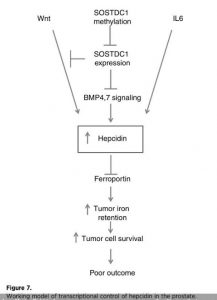This post is for about dealing with cancer. I am going to be quite blunt and say that cancer is not a medical disease. Iron causes cancer. If you still have serious doubts about this obvious metabolic connection please take a few moments to read this momentous study:
Tesfay, L., et al. (2015). “Hepcidin Regulation in Prostate and Its Disruption In Prostate Cancer.”
https://cancerres.aacrjournals.org/content/canres/75/11/2254.full.pdf
Keep in mind the authors go to great lengths to suggest that this only applies to prostate cancer, which is the #1 cause of cancer in men. It is also the second leading cause of cancer-related deaths as well.
This study has changed how I look at how this works and I disagree with the narrowcasting of these results. As you may know from earlier posts, my Dad died when I was 16 of lung cancer, then my Mom’s older sister died of liver cancer and my sister has had double breast cancer and lives to see another day means that I am no stranger to this tragic condition.
I believe the points made in this study, i.e. the role of iron in promoting cancer are universal and should totally change our perception of what actually causes “cancer”.
I have provided a dot connecting points as I synthesize this research:
- Inflammation >>
- Presence of cytokines (IL-6) >>
- Increased production of hepcidin >>
- Increased destruction of ferroportin >>
- Increased retention of iron in the cancer cells >>
- Increased carcinogenic activity of the cell.
I want to draw your attention to Fig. 7. noted below that highlights this cascade of events with particular emphasis on the increase of hepcidin that blunts ferroportin’s key function to ensure proper iron circulation.

This blunting of ferroportin then leads to three stunning outcomes in those with cancer:
- Increased retention of iron within the tumor
- Increased tumor cell survival
- Increased likelihood of a poor clinical outcome
As you know from my previous iron toxicity posts about iron and copper metabolism, this study reminds you that iron is regarded as the perfect carcinogen.
Did you know that it is the only element on this planet that meets all three criteria to be considered a carcinogen?
- Iron initiates cancer
- Iron promotes cancer
- Iron progresses cancer
Source: Moon, J. (2008). “Iron: The Most Toxic Metal.”
Dr. Moon goes on to describe the unique characteristics of this ultimate carcinogen by noting, and I quote from his mind-bending book:
- Iron activates xenobiotics (foreign chemicals) turning them into carcinogens
- Iron is a factor leading to alcoholic liver cirrhosis, a precursor to liver cancer
- Iron acts synergistically with viral infections in causing cancer
- Iron multiplies aflatoxin (hepatic mycotoxin from mold) carcinogenicity
- Iron plays a critical role in causing cancer cells to become more aggressive and invasive
This pretty much seals the deal on how and why cancer rates have risen to outrageous levels through this iron dominated planet. 100 years ago, the incidence of cancer was 1 in 20. Today it is 1 in 2.
The cause of cancer is iron. There is some confusion about the origin of inflammation but I encourage you to look past what it is thought of and follow the compelling dots points of how this same magnesium deficiency and iron toxicity dynamic affects a mineral deficient body. Not to mention how it creates all manner of chronic conditions such as cancer:
- Inflammation is caused by magnesium deficiency
Weglicki, W.B., Phillips, T.M. (1992). “Pathobiology of magnesium deficiency: a cytokine/neurogenic inflammation hypothesis.”
https://www.physiology.org/doi/abs/10.1152/ajpregu.1992.263.3.r734
Inflammation is not a medical disease. It is, however, a clinical sign of magnesium deficiency and initiates the production of substance P, which triggers the inflammatory cascade of all cytokines and chemokines. NF-kB initiates the release of IL-1a, IL-6, and many other peptides. Note that this is the origin of the IL-6 that plays such a key role to start the synthesis of hepcidin in the prostate tissue. I would argue, this is happening in tissue all over the body.
- It is a known fact that iron accumulates in the tissue of magnesium deficient critters (4-legged & 2-legged!):
Kimura, M., Yokoi, K. (1996). “Iron accumulation in tissues of magnesium-deficient rats with dietary iron overload.”
https://www.ncbi.nlm.nih.gov/pubmed/8907021
Sanchez-Morito, N., et al. (2000). “Influence of magnesium deficiency on the bioavailability and tissue distribution of iron in the rat.”
https://www.semanticscholar.org/paper/Influence-of-magnesium-deficiency-on-the-and-tissue-Sanchez-Morito-Planells/4a9799be01dbae10ae3f003c8f3bc0d52a02b298
I think it is highly relevant that in the former study, they note that
“…magnesium deficient rats with iron overload may be used as an experimental hemochromatosis model.”
- It appears that hepcidin expression is increased in critters that are magnesium deficient:
Ishizaki, N., et al. (2011). “Hepcidin expression in the liver of rats fed a magnesium deficient diet.”
https://www.ncbi.nlm.nih.gov/pubmed/21736832
Note many of the same players, especially BMP-6, are described in this process of increased iron accumulation in the tissue of a magnesium deficient body. I believe that most critters on this planet are magnesium deficient! Therefore, most stand the increased chance for increased iron storage.
Now the literature is relatively silent on what I believe is a metabolic fact: Iron causes Inflammation. So, given my inspired assertion:
- If magnesium deficiency causes inflammation
- Iron builds
- Hepcidin expresses more in magnesium deficient tissue
Do you think that iron is causing inflammation? This then leads to a slight modification of the initial dot connecting:
Iron causes inflammation >>>
Presence of cytokines (IL-6) >>>
Increased production of hepcidin >>>
Increased destruction of ferroportin >>>
Increased retention of iron in the cancer cells >>>
Increased carcinogenic activity of the cell
The build up of iron due to the systemic lack of magnesium and ceruloplasmin causes the very inflammation that triggers the cellular signaling toward carcinogenic activity that then causes further iron retention leading to further cancer activity.
The circular nature of this destructive pathway is mind numbing. What’s the one word that is totally missing in this scintillating study on prostate cancer? Ceruloplasmin!
Here is the gist of why we are all in such a quandary:
“Therefore, the ceruloplasmin-ferroportin system represents the main pathway for cellular iron egress and it is responsible for physiological regulation of cellular iron levels.”
Musci, G. et al. (2014). “Ceruloplasmin-ferroportin system of iron traffic in vertebrates.”
https://www.ncbi.nlm.nih.gov/pmc/articles/PMC4050113/pdf/wjbc-5-204.pdf
The iron-based literature goes to great lengths to create a connection between hepcidin <> ferroportin, but they totally ignore ceruloplasmin. Keep in mind, Hepcidin, is a hormone with 25 Amino Acids. Ceruloplasmin (Cp), on the other hand, is one of the most important enzymes to grace the human body, has 1,046 amino acids and 8 copper atoms (4 Cu+/4 Cu++ surrounding an oxygen molecule). Yes, we can all certainly understand why they would ignore this powerhouse metabolic player, given the dynamics of clinical actions today.
I would encourage you ALL to read this critical study by Musci, et al., to better understand how to keep hepcidin from going rogue and thus causing a build-up of stored iron in your tissue that will eventually lead to a carcinogenic growth.
Tesfay, et al., 2015, the first article I mentioned completely overlooked this foundational enzyme fact in their study on prostate cancer should send a chill down our collective spines. How do they not know or even acknowledge the known regulatory role of ceruloplasmin and its critical impact on the regulation of the management of iron inside and about the cell?
I implore you to realize how the hallowed halls of clinical research that these iron-focused researchers are doing, connecting critical dots and at the same time overlooking pivotal pieces of the puzzle.
A votre sante!
MORLEY M. ROBBINS
For Facebook Discussion:
www.facebook.com/groups/MagnesiumAdvocacy/permalink/1211975545537179/
